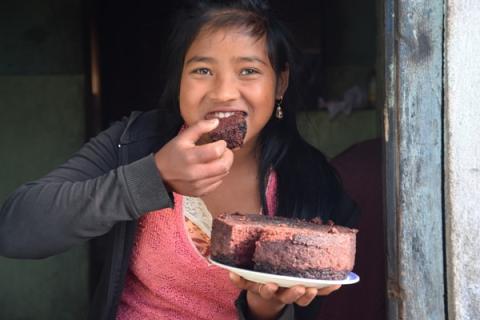
Whether eaten hot and steaming as part of every meal, or made into cakes and crepes and eaten with sweet red tea, rice occupies a central place in Khasi cuisine and indeed the cuisine of all tribes in Meghalaya. But the unique thing about rice dishes in Meghalaya is how their taste varies across different regions of the state, deriving as much from the innumerable indigenous varieties of rice grown here as from a particular recipe.
Pusaw is one such traditional Khasi snack. Made from a very special variety of red rice grown in the hills and paddy fields of Khasi Hills, the most famous Pusaw comes from the small village of Mawranglang in the South West Khasi Hills district. Since this snack has no artificial ingredients or preservatives and neither does it have excess sugar, it is a healthy and delicious accompaniment to the sweetened red tea popular among the Khasis. In Shillong one can find authentic Mawranglang Pusaw in Motphran and lewduh, but also in a few local tea stalls.
Making Pusaw the Traditional Way
The rice is first thoroughly cleaned then soaked in water for at least two hours. After the water is drained using traditional baskets known as Khoh or Shang, the rice is pulverized to powder using a mortar and pestle. While the rice powder at this stage looks fine to the untrained eye, only the most fine grained rice powder will do for good Pusaw. The rice powder is thus sieved multiple times before it is used for cooking.
The traditional method of making Pusaw involves first making a paste by mixing the fine rice powder with a small amount of warm water. Then, edible soda is added in the proportion of 1 kilo rice to a pinch. A minimal amount of sugar is also added to the mixture at this time.
Next, the cooking pot is heated in a traditional clay stove and oil is slowly added. Once the oil is hot, the paste is poured into the pot and the pot is covered. On the over are kept a few pieces of charcoal so that the pot is evenly heated from all sides and the rice is soaked from the top as well.
Local Flavours
There are two types of Pusaw - Plain and `Special`. The `Special` Pusaw is where local variations in this dish comes in, but common additional ingredients include orange rind and egg. Since the West and South West Khasi Hills areas are famous for their oranges, the flavour of these local oranges and the texture of the local rice make for a beautiful, extremely aromatic combination.
Making a livelihood out of Pusaw
Today, nearly 70% of the households in Mawranglang are engaged in making and selling Pusaw as a key livelihood activity, and have also begun passing this livelihood tradition to the next generation.
The Pusaw from Mawranglang is especially popular and highly in demand even by urban consumers. It is supplied to several big markets including Mawkyrwat, Nongstoin, Mawngap, Mawsynram, Nongjri and Shillong.
Each household in Mawranglang cooks 20-30 Pusaw cakes per day during summer and almost 80-100 during various festive seasons. Plain Pusaw is sold at Rs. 80 for an average sized Pusaw while Specia Pusaw is sold at Rs. 100. They derive a profit of about 20-30 per Pusaw.
Preserving the brand value of Mawranglang Pusaw
A Key challenge that the people of Mawranglang face in marketing and selling their traditional snack is that a number of other communities have also begun making and selling their versions of Pusaw after witnessing the success of Mawranglang. While the basic recipe stays the same, the difference between Pusaw from Mawranglang and that from other villages lies in the taste. Connossieurs of Mawranglang Pusaw can spot the difference and differentiate this Pusaw from others.
The community members of Mawranglang village have decided to form a Pusaw society to collectively address this challenge and create a marketable brand for their authentic version of Pusaw. By forming a society, cooperative or a self-help group, the community members believe that they will be better able to access marketing and funding resources under formal government schemes, bank schemes or NDO programmes. The Enterprise Resource Persons (ERPs) at the Mawkyrwat Enterprise Facilitation Centre (EFCs) have been guiding them through the process.
In addition to initiating better branding and marketing, the Mawranglang community is also trying to explore possibilities of creating a Geographic Indication (GI) or patenting for their Pusaw.
- Log in to post comments
